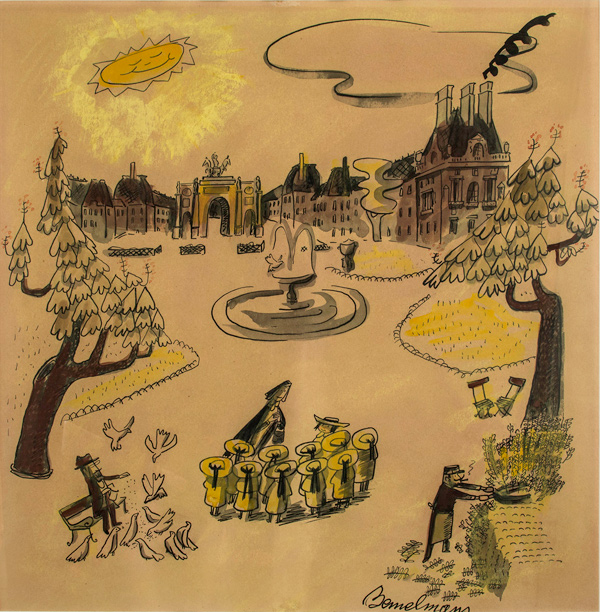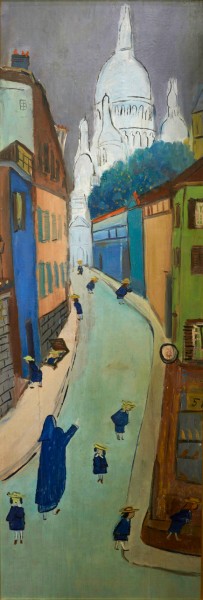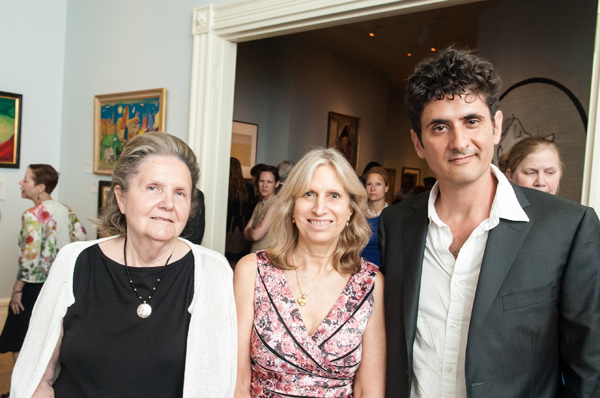Madeline’s 75th Birthday Brings Revelations

"Madeline at the Paris Flower Market," 1955. Oil on canvas.
Credit: The Estate of Ludwig Bemelmans; © Ludwig Bemelmans, LLC
Madeline turns 75 this year, though you would hardly know it. Her adventures are as fresh as when the first Madeline book was published in 1939 by Simon & Schuster. It’s a time for celebration—and for some revelations about the old house in Paris that was covered with vines, its smallest inhabitant, and Ludwig Bemelmans, Madeline’s creator. Most wouldn’t assume that Bemelmans and his little Parisian schoolgirl had a strong connection to New York City. But the current exhibit at the New-York Historical Society Museum & Library, Madeline in New York: The Art of Ludwig Bemelmans, reveals otherwise. Jane Curley, the exhibit’s curator, has gathered 120 items to celebrate Madeline’s 75th. The show includes Bemelmans’s art from all six Madeline books, panels he created for billionaire Aristotle Onassis’s yacht, menus he designed for famed New York City restaurants, and much more.
Bemelmans came to New York City in 1914 and worked as a busboy at the Ritz Hotel and a newspaper cartoonist and magazine illustrator before being discovered by May Massie, an editor at Viking, who was convinced he had potential as a children’s book author. Massie was also instrumental in launching the careers of Robert McCloskey and other authors.
"One Nice Morning Miss Clavel Said,” 1939. Crayon and watercolor. Collection of Mr. and Mrs. Charles M. Royce. © Ludwig Bemelmans, LLC. Credit: New-York Historical Society
On display is a drawing from Bemelmans’s second children’s book, The Golden Basket (Viking, 1936), where Madeleine made her first appearance. Bemelmans later dropped the “e” from her name to facilitate rhyming. The Golden Basket received a Newbery Honor in 1937.
“They Went Looking High,” 1953, an oil panel from Aristotle Onassis's yacht.
Collection of Mr. and Mrs. Charles M. Royce. © Ludwig Bemelmans, LLC

Left to right: Barbara Bemelmans, daughter of Ludwig Bemelmans; New-York Historical Society president and CEO Louise Mirrer; John Bemelmans Marciano, Barbara's son. Credit: The New-York Historical Society
Curley spent three years assembling the exhibition, traveling from Kansas to Paris in the process. Additional items include lampshades from the Bemelmans Bar at the Carlyle Hotel in New York City, where the mural that the artist painted in 1947, in exchange for living accommodations, remains intact, and a fan letter from Jacqueline Kennedy, written while she was first lady, which launched a friendship between the author and former first lady. The show also includes works from Bemelmans’s other books, including a watercolor from Parsley (Harper, 1955), a book about deer and the environment that Bemelmans developed with the famed children’s book editor Ursula Nordstrom. Another item, created by artist Adrienne Ottenberg, is Bemelmans' New York: A Map of His Favorite Haunts, Some Still Here and Some Departed."4 Facts About Ludig Bemelmans and Madeline You Didn't Know":
- Madeline was a combination of his mothers, wife, and daughter. He remembered his mother's stories of convent schools, with the little beds in two rows, the two straight lines, and the girls all dressed alike. But it was also a part of Bemelmans himself (the smallest in class, always in trouble.)
- Best known for his Madeline books, Bemelmans was also a novelist and nonfiction writer, as well as a contributor to The New Yorker (he did many cover illustrations for this magazine), Vogue, Holiday, and Town and Country. Late in life, he decided to pursue his lifelong desire to paint with oils. His work is on display at the Metropolitan Museum of Art in New York and the Museé National d'Arts of Paris.
- Born in Tirol, Austria, Bemelmans enjoyed an idyllic childhood until he was six, when his father left his family. Both he and his pregnant mother left for her family's home in Germany, where she was the first divorced woman in Regensberg. This began a series of highs and lows in the author's life.
- When Bemelmans traveled to America as a young man in 1914, he found work as a busboy at the Ritz-Carlton. Here, he began sketching caricatures of the guests. In one instance, he gave some patrons some insulting sketches of them instead of menus. Narrowly escaping being dismissed, Bemelmans was encouraged by his boss to continue drawing.
Madeline in New York: The Art of Ludwig Bemelmans runs at the New-York Historical Society until October 19. It will be on view at the Eric Carle Museum of Picture Book Art in Amherst, MA, from November 15, 2014 to February 22, 2015.
Add Comment :-
RELATED
The job outlook in 2030: Librarians will be in demand
The job outlook in 2030: Librarians will be in demand
ALREADY A SUBSCRIBER? LOG IN
We are currently offering this content for free. Sign up now to activate your personal profile, where you can save articles for future viewing





